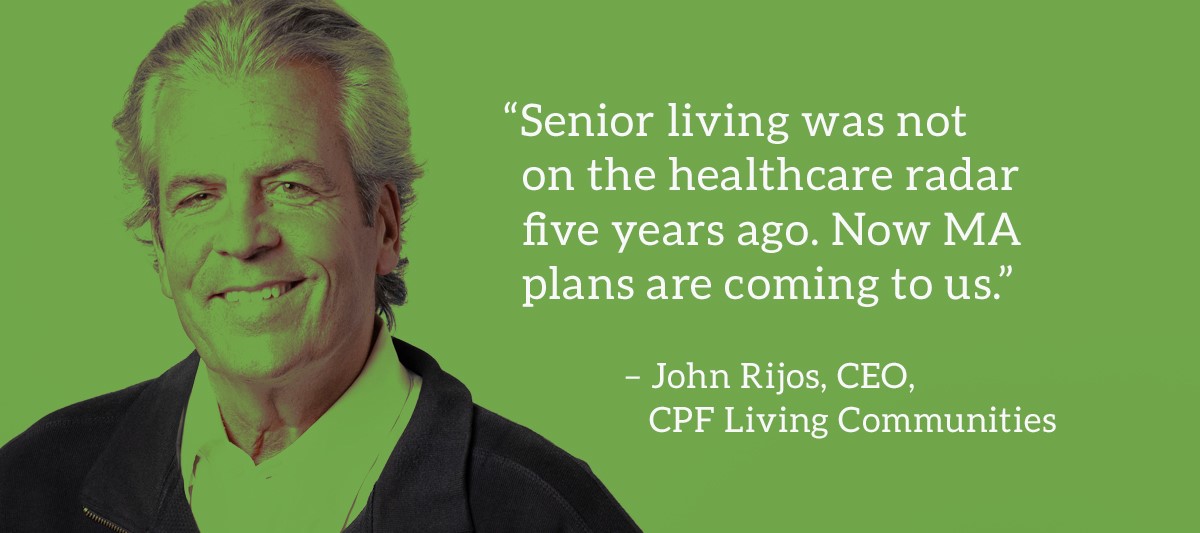What does it take to get advocacy groups, insurance companies, foundations, and policy makers all on the same sheet of paper? In the case of caring for chronically ill older Americans, it appears that it takes a shared sense that improved outcomes, lower costs, and strong business performance are achievable – but only with cooperation, innovation, and a willingness to think differently.
On January 7, we attended an extraordinary and encouraging presentation hosted by Senator Mark Warner’s office, made possible by The SCAN Foundation, and led by the Long-Term Quality Alliance (LTQA), and Anne Tumlinson Innovations (ATI). Titled “Medicare Advantage and the CHRONIC Care Act: Implementing Innovative, Non-Medical Solutions for Older Adults,” the event served to launch and support a set of newly developed guiding principles for an updated Medicare program.
The principles in question were arrived at by an unusual working group convened by ATI and LTQA. As described in the accompanying white paper, “A Turning Point in Medicare Policy: Guiding Principles for New Flexibility Under Special Supplemental Benefits for the Chronically Ill,” the group was “comprised of a diverse array of national experts on Medicare Advantage and long-term services and supports.” The white paper lists the group’s members, stating their support and commitment; it’s a collection of leaders from entities that in other settings have sometimes found reason to take potshots at each other in the press or to cast blame for inaction. We are not accustomed to seeing them working together in a consensus-building process.
Members include classic advocacy groups, such as AARP, The Arc of the United States, the National Council on Aging, the Community Living Policy Center UCSF, the National Association of Area Agencies on Aging, Meals on Wheels America, and Justice in Aging. What makes the group particularly rare is the fact that all these groups worked side-by-side in a collaborative process with leading insurers such as Kaiser Permanente, Centene, CVS Health Aetna, Anthem, Blue Cross Blue Shield Association, and others. Add to the mix funders such as The SCAN Foundation, The Commonwealth Fund, and the Robert Wood Johnson Foundation, and you truly have strange bedfellows. But what they’ve achieved could only be brought about by such an array – and by a shared understanding of a common challenge: to deliver better outcomes at lower cost through utilization of the new flexibility in care for the chronically ill.
Clearly, these leaders have listened to one another and reached agreement on how best to move forward and take advantage of an unprecedented opportunity: the passage of a new law named “Creating High-Quality Results and Outcomes Necessary to Improve Chronic (CHRONIC) Care Act.” Enacted as part of the Bipartisan Budget Act of 2018, the law, as summarized in the white paper, which is subtitled “Guiding Principles for New Flexibility Under Special Supplemental Benefits for the Chronically Ill (SSBCI),” “expands what qualifies as a supplemental benefit to meet the needs of chronically ill Medicare Advantage enrollees.”
The white paper further explains:
“Prior to the CHRONIC Care Act, Medicare Advantage plans could only offer supplemental benefits that were primarily health related, such as dental care, and had to make them available to all plan enrollees. Through the CHRONIC Care Act, Medicare Advantage plans may now offer SSBCI. These benefits may include services that are not primarily health related, such as home care, as long as the service has a reasonable expectation of improving or maintaining the health or overall function of the chronically ill enrollee. The new law also gives the Secretary of Health and Human Services the authority to waive, only with respect to SSBCI, the requirement that benefits be made available to all enrollees.”
A review of the “Guiding Principles” that the group has released indicates that they see a real opportunity in the flexibility now afforded to MA plans to tailor benefits to the needs of a particular individual, rather than to an entire class of plan beneficiaries, as required under former rules. If payers and providers can address the individual needs of the chronically ill population, not all of which are directly health-related, they may have a significant impact on health and healthcare utilization.
This working group is extraordinary, not only for including such an array of interested parties, but for arriving at a shared vision “to guide a diverse array of stakeholders as they work to develop, implement, offer, deliver, and use SSBCI.” The group also serves as hard proof that as our healthcare system continues to move towards value-based care new partnerships will arise – often putting strange bedfellows together in ways they might not have imagined just a few short years ago.
But there are tensions that are real and must continually be addressed. Providing insurers greater flexibility so that they will innovate may be necessary, but there are concerns around giving them too much freedom. It is also likely that some innovations will fail. Convening major players representing such a broad array of interests ensures that every perspective is accounted for, as the system seeks to innovate without failing the people and institutions that it serves. The principles account for a realistic balance of these interests, while providing the tools necessary for everyone to play a role in achieving the common aim.
While every other stakeholder was well-represented, health systems were noticeably absent from this effort. They will likely be the last institutions to fully buy in to value-based care. Most systems today are still operating on the fee-for-service system, and few, if any, have developed expertise in managing chronic diseases, or pre- and post-acute care. These factors, along with their traditional focus on curative intervention may underlie their absence, but as everyone else works diligently to keep patients out of the hospital, and to renew the focus on value-based care, even health systems will have to evolve, or else suffer the consequences of a disruption in their markets.
There is a great opportunity to learn from this period. The working group recognizes that this is the “beginning of a path toward person-centeredness in Medicare.” They include as a principle that the SSBCI should “evolve with continuous learning and improvement.” To be successful over the long-term we will need research, with reporting requirements, as outlined under this principle. We will need some of these stakeholders to pilot innovative programs, measure and compare results, and test new ideas. Across the program, we will need to “build the evidence base” – which is one of several suggested next steps in the white paper – as these initiatives develop.
There is plenty of work to do, both to address major challenges in our approach to caring for frail elders (and everyone else) and to seize new opportunities to succeed. But this unique and surprising effort indicates that our institutions are willing to work together to be successful. And that’s a turning point.





